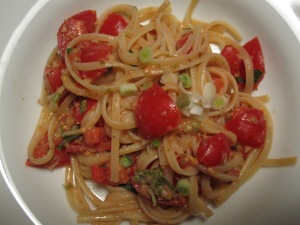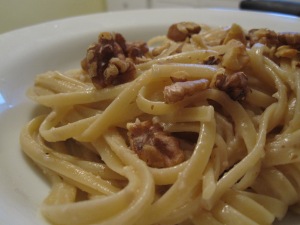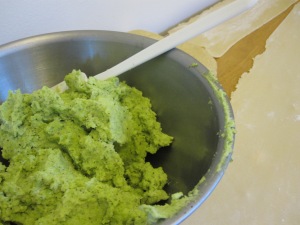
A couple weeks ago, I signed up for a meat CSA program through Marin Sun Farms. Once a month, we’ll get a random assortment of braising and roasting cuts and ground meat from grass fed, pasture raised, humanely treated animals. Our first shipment arrived February 11 and the meat looked amazing. We celebrated Valentine’s day by cooking up these beef back ribs, which were included in our first shipment.
To go with it, I decided to try my hand at homemade pasta. This was the first time I’ve made homemade pasta and it was much, much simpler than I ever imagined. I’ve got a Kitchenaid pasta roller attachment, bought ages ago with a William Sonoma gift card. It had languished unused in the box for over a year, but I’m happy to report that its maiden voyage was a smooth one. I used the recipe that came with the roller and I had no problems whatsoever. I bought some beautiful mushrooms at the farmers market, but unfortunately, the name of them escapes me. I sauted those with kale and served that with the beef over the pasta. Fantastic, especially with a nice bottle of cabernet from Jessup Cellars in Napa.

I didn’t have time this week to prepare a completely local meal, so I’m counting this as my Dark Days contribution for the week. Everything here is local, except for the flour I used in my pasta. I realize that’s a pretty substantial exception, so this isn’t the my best work. But, it is what it is. For next year’s challenge, I’ll hopefully own a car and I can drive around in search of local flour. Until then, I’ll just count my local blood, sweat and tears in making it myself.
Braised Beef Back Ribs with Mushrooms and Kale
Recipe by me
Ingredients
1.5-3 pounds of beef back ribs
4 cups of red wine
3 or 4 carrots, sliced in three inch chunks
One onion, cut into large chunks
A few sprigs of thyme
2 cups of mushrooms, sliced
1 small bunch of Tuscan kale, thick stems removed, and chopped into 1 inch ribbons
1 large shallot
1 tablespoon of butter
Olive oil, salt, and pepper
1 pound of pasta, preferably a wide, flat noodle such as pappardelle
Directions
Preheat oven to 325 degrees. In a dutch oven or oven safe pan, heat up a couple tablespoons of olive oil. Place the rack of ribs in and brown all over, about 5 minutes. Add about 3 cups of wine, the carrots, onions, and a few sprigs of thyme. Add salt and freshly ground pepper, cover and put in the oven for about 1.5 hours, checking after an hour or so to see if more liquid is needed, and if so, add a bit more wine or some water.
When the meat seems tender, take the pot out of the oven, remove the meat, cover, and set aside. Remove the thyme springs. Transfer the vegetables and cooking liquid to a blender or food processor, pureeing until smooth. Add a little more wine if the mixture seems too thick.
Pour the liquid back in the dutch oven and put the meat on top. Cover again and put it back in the oven. If the meat is done enough for you, just set it on warm. Otherwise, keep it at 325 or so until you are ready to eat.
Meanwhile, heat a skillet over medium heat. Add one tablespoon olive oil and one tablespoon butter. When the butter melts, add the diced shallot, and slowly cook until it begins to carmelize. Add the kale, tossing to coat. Add one cup of wine and cover. Simmer over medium low for about 10 minutes, until kale starts to soften. Add the sliced mushrooms, cover again, and continue to cook another five minutes or so. Add salt and pepper.
Cook the pasta. When draining, reserve a cup or so of the water.
To put everything together, take the meat out of the oven and slice the ribs. Add a bit of the pasta water to the vegetable puree if needed. Toss the pasta with the kale and mushrooms, adding a bit of pasta water if needed. Serve the pasta in bowls, with a rib and some vegetable puree spooned over it.
We cooked a pound of pasta because that’s what the recipe called for, but we only had three beef ribs. So we just tossed the vegetable puree in with the rest of the pasta and ate it without the meat for leftovers. But doubling the amount of meat would probably result in 6 hearty portions.

Read Full Post »






















